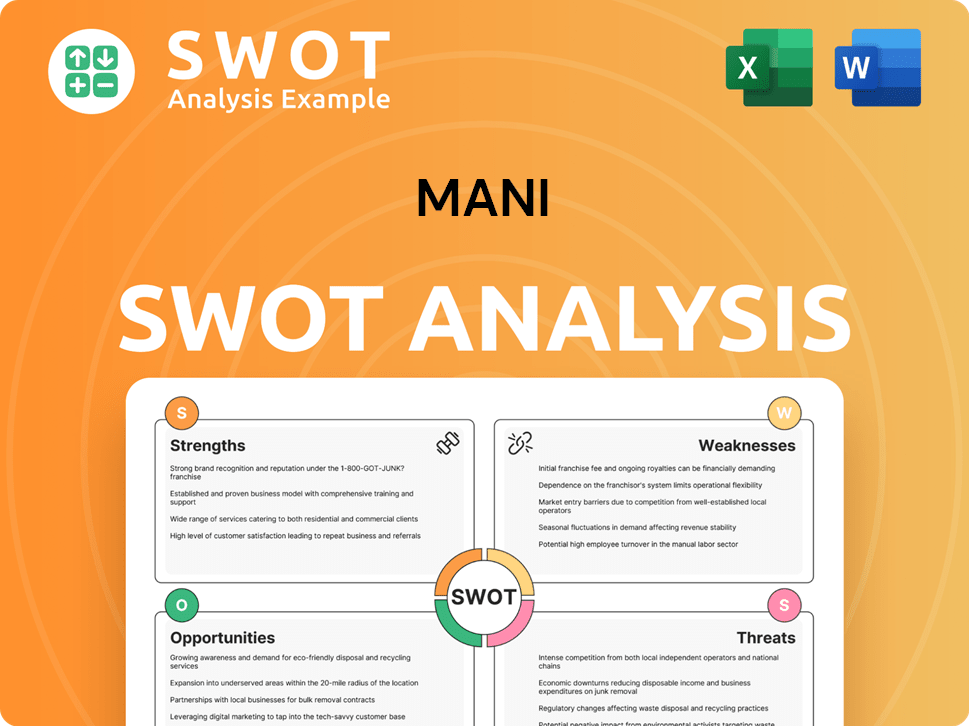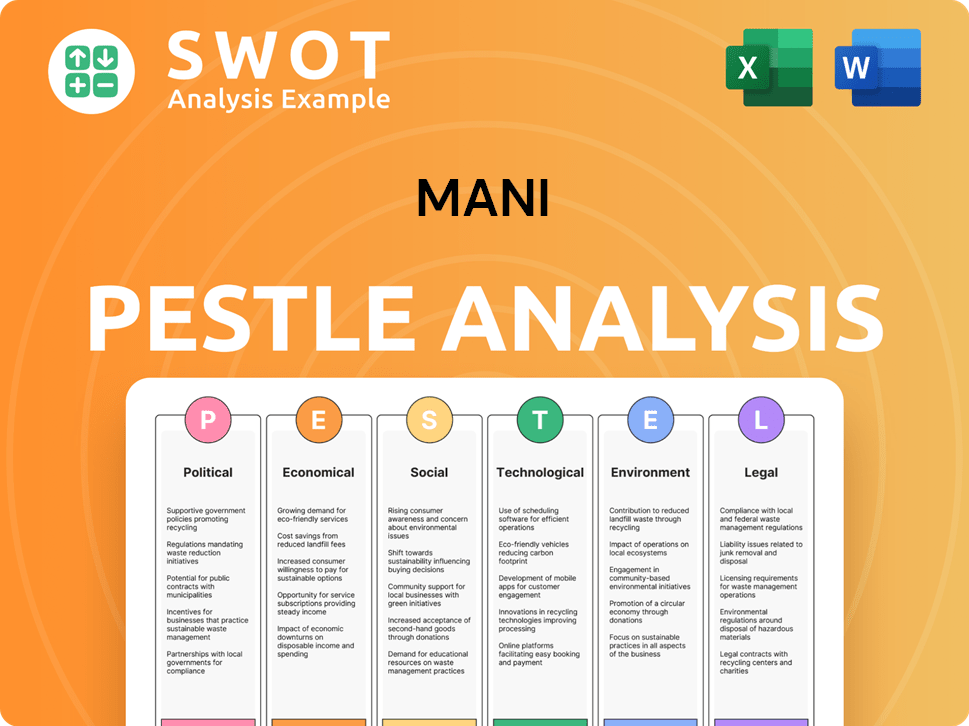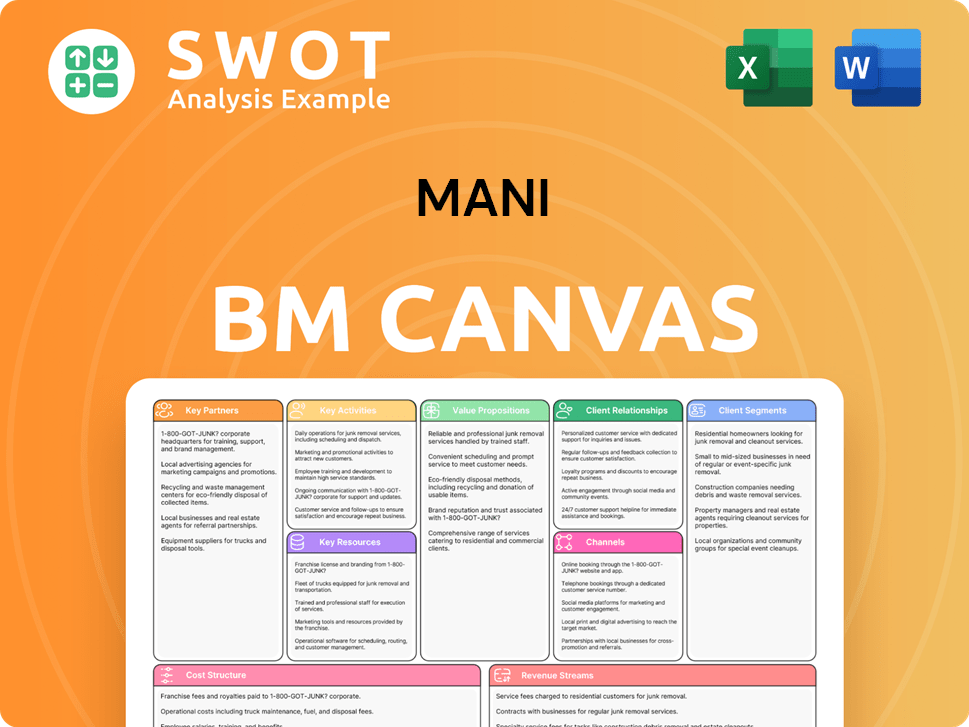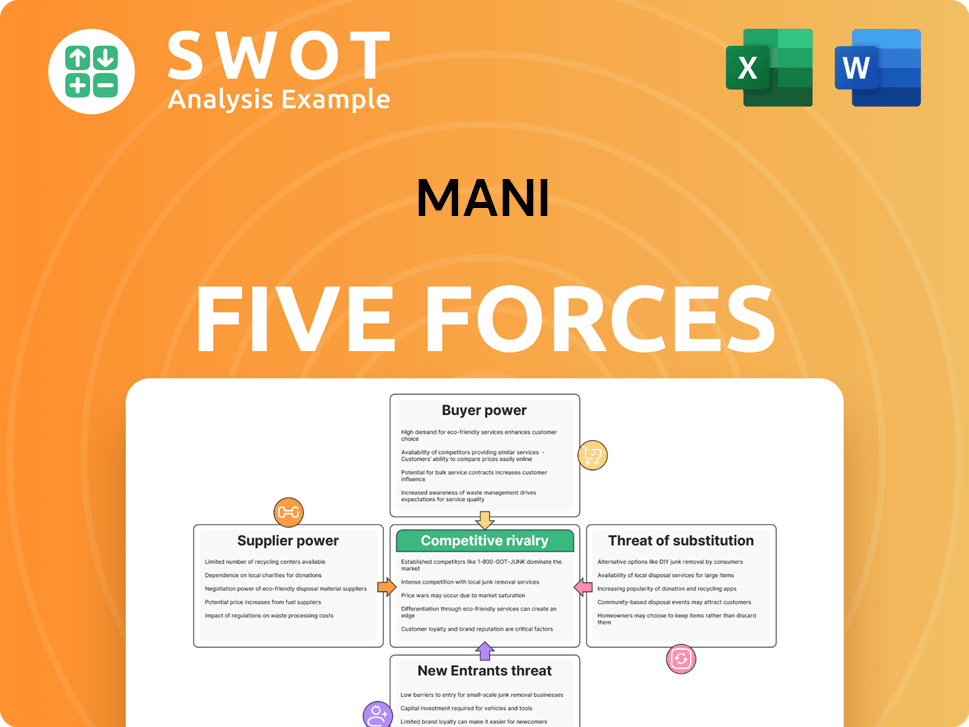Mani Bundle
How did a Japanese company revolutionize surgical instruments?
Delve into the fascinating Mani SWOT Analysis to uncover the story of Mani Company, a global leader in medical devices. From its humble beginnings in 1956, Mani has consistently pushed boundaries, driven by a commitment to quality and innovation. Discover how this Japanese company transformed the surgical landscape.

The Mani Company history is a testament to the power of vision and dedication. Founded by Masao Matsutani, Mani's journey from manufacturing rust-proof surgical needles to becoming a global supplier of surgical instruments is truly inspiring. Explore the key milestones, including the introduction of the world's first 18-8 stainless steel surgical needle, that shaped Mani's legacy in the medical devices industry. This brief history of Mani reveals its enduring impact on global healthcare.
What is the Mani Founding Story?
The Mission, Vision & Core Values of Mani traces back to May 1, 1956, marking the inception of the company. Masao Matsutani, the founder, began manufacturing and selling eyed surgical needles made from steel in Takanezawa, Tochigi Prefecture, Japan. His foresight in identifying the need for rust-resistant surgical instruments set the stage for the company's future.
Matsutani's initial focus was on addressing a critical issue in the medical field: the rusting of steel surgical needles, which posed risks to patient safety. This led him to pursue the development of stainless steel needles, a significant innovation at the time. This commitment to quality and innovation became a core principle.
In 1959, Matsutani formalized his business as MATSUTANI SEISAKUSYO CO., LTD., with a capital of 1 million yen. The company's name, 'Mani,' was derived from the founder's name, 'MA' and 'NI' of Matsutani. This strategic move, combined with a focus on an unmet medical need, laid the foundation for Mani's growth and its lasting impact on the medical device industry.
Mani's early years were marked by innovation and a commitment to addressing critical needs in the medical field.
- May 1, 1956: Masao Matsutani begins manufacturing and selling steel surgical needles.
- 1959: Matsutani reorganizes his business as MATSUTANI SEISAKUSYO CO., LTD.
- Development of 18-8 stainless steel eyed surgical needles.
- The name 'Mani' is derived from the founder's name.
Mani SWOT Analysis
- Complete SWOT Breakdown
- Fully Customizable
- Editable in Excel & Word
- Professional Formatting
- Investor-Ready Format

What Drove the Early Growth of Mani?
The early growth of Mani, formerly Matsutani Seisakusho, was marked by significant innovation and strategic expansion. The company's focus on product development, particularly in surgical instruments, and its proactive approach to international markets, set the stage for its future growth. This period saw Mani establish itself as a key player in the medical devices industry, expanding its product lines and global footprint.
In 1961, Mani developed the world's first 18-8 stainless steel surgical needles, a crucial advancement in surgical tools. This innovation addressed the issue of rust in existing steel needles, significantly improving the quality and safety of surgical procedures. This breakthrough led to eligibility for a national subsidy for export promotion in 1962, boosting the company's international presence.
Mani expanded its product portfolio, entering the dental instruments market in 1976. In 1993, the company launched sterilized ophthalmic sutures, which quickly gained market share. The company officially changed its trade name to MANI, INC. in 1996, coinciding with its strategic focus on overseas expansion. This diversification was critical to the company's growth.
International expansion was a key driver for Mani. Pre-processing of stainless wire began in overseas factories in Vietnam (since 1996, with a second factory in 2003) and Myanmar (since 1999). Precision processing and laser drilling remained in Japan, utilizing proprietary technology. In 2003, Mani established MANI HANOI CO., LTD. in Vietnam for overseas production.
Mani expanded its sales network in Asia with MANI MEDICAL BEIJING CO., LTD. in China in 2012. The acquisition of GDF (Germany) in 2015 added composite resins to its business portfolio. Mani actively engaged in direct marketing and collaborated with doctors and dentists globally. As of February 28, 2025, Mani reported a trailing 12-month revenue of $193 million, demonstrating sustained growth.
Mani PESTLE Analysis
- Covers All 6 PESTLE Categories
- No Research Needed – Save Hours of Work
- Built by Experts, Trusted by Consultants
- Instant Download, Ready to Use
- 100% Editable, Fully Customizable

What are the key Milestones in Mani history?
The Mani Company history is marked by significant achievements in the medical device industry. The Japanese company has consistently pushed boundaries, as evidenced by its pioneering products and strategic responses to market dynamics. The Mani Company has established itself as a key player in the surgical instruments sector.
| Year | Milestone |
|---|---|
| 1961 | Developed the world's first '18-8' stainless steel surgical needle, revolutionizing the medical field. |
| 1991 | Introduced the world's smallest drilled eyeless needle (27μm) for trial, showcasing advanced manufacturing capabilities. |
| 1991 | Developed a skin stapler, expanding its product range and market reach. |
| 2008 | Received the prestigious Porter Prize, recognizing its innovative contributions. |
| 2013 | Developed state-of-the-art metal skeletons for stent grafts, furthering its commitment to innovation. |
Mani Company has consistently demonstrated its commitment to innovation throughout its brief history Mani. The company's portfolio includes 310 patents, with 221 non-Japanese patents and 148 pending patents, highlighting its continuous investment in research and development.
The development of the '18-8' stainless steel surgical needle in 1961 was a groundbreaking achievement, solving the issue of rust and improving surgical outcomes. This innovation set a new standard in the industry, enhancing the durability and safety of surgical instruments.
Mani Company introduced the world's smallest drilled eyeless needle (27μm) in 1991, demonstrating its advanced manufacturing capabilities. This innovation allowed for more precise and less invasive surgical procedures, improving patient outcomes.
The introduction of a skin stapler in 1991 expanded the company's product range, offering surgeons an efficient alternative to traditional suturing. This innovation streamlined surgical procedures and improved patient recovery times.
In 2013, Mani Company developed state-of-the-art metal skeletons for stent grafts, showcasing its expertise in advanced materials and manufacturing. This innovation has contributed to advancements in vascular surgery.
Mani Company maintains a robust patent portfolio, with 310 patents, including 221 non-Japanese patents and 148 pending patents. This demonstrates the company's ongoing commitment to innovation and protection of its intellectual property.
The receipt of the Porter Prize in 2008 recognized Mani Company for its innovative contributions and strategic excellence. This prestigious award further validated the company's commitment to innovation and quality.
Mani Company faces intense competition in the medical equipment market, requiring strategic adaptation to maintain its market position. The company's strategy of specializing in niche markets and focusing on high-value products, rather than engaging in price wars, is a key aspect of its competitive approach. For more insights into the competitive landscape, consider exploring the Competitors Landscape of Mani.
The medical equipment market is highly competitive, with major global players vying for market share. Mani Company navigates this environment by focusing on niche markets where it can leverage its unique core technologies.
An internal crisis in its China operations negatively impacted trust and stock price, leading to leadership apologies and management changes. Mani Company is continuously working to strengthen its global production system and expand its global market share.
While some competitors in the dental segment lowered prices, Mani Company maintained its pricing strategy, focusing on products that offer high added value. This approach reflects a strategic decision to prioritize profitability and product differentiation.
Ongoing initiatives include strengthening its global production system and conducting R&D with key opinion leaders worldwide. These efforts are aimed at overcoming challenges and adapting to market dynamics.
Mani Company is expanding its global market shares through regional-oriented sales strategies. This approach allows for better targeting of specific market needs and preferences, enhancing its global presence.
The company's focus on high-quality products and continuous innovation is crucial for maintaining its competitive edge. This dedication to excellence is reflected in its product range and market reputation.
Mani Business Model Canvas
- Complete 9-Block Business Model Canvas
- Effortlessly Communicate Your Business Strategy
- Investor-Ready BMC Format
- 100% Editable and Customizable
- Clear and Structured Layout

What is the Timeline of Key Events for Mani?
The Mani Company history is marked by significant innovations and strategic expansions. Beginning in 1956 with the independent manufacturing of surgical needles, the company has consistently evolved, from developing the world's first stainless steel surgical needles in 1961 to entering the dental segment in 1976. Further milestones include the introduction of the smallest drilled eyeless needle in 1991 and the establishment of overseas production in Vietnam in 2003. The company changed its trade name to MANI, INC. in 1996, and in 2012, it was listed on the Tokyo Stock Exchange. Recent developments include the completion of a new head office factory in Germany in September 2023, the commencement of marketing activities in Malaysia in November 2023, and the establishment of a presence in North America in September 2024. In April 2025, a partnership with Microsurgical Technology (MST) was announced for the distribution of ophthalmic surgical blades in the U.S.
| Year | Key Event |
|---|---|
| 1956 | Masao Matsutani started manufacturing and selling eyed surgical needles. |
| 1961 | Developed the world's first 18-8 stainless steel surgical needles. |
| 1976 | Entered the dental segment, expanding the range of surgical instruments. |
| 1991 | Introduced the world's smallest drilled eyeless needle (27μm). |
| 1996 | Changed trade name to MANI, INC., marking a significant corporate identity shift. |
| 2003 | Established MANI HANOI CO., LTD. in Vietnam for overseas production. |
| 2012 | Traded on the First Section of the Tokyo Stock Exchange. |
| 2023 | Completed New Head Office Factory for MANI MEDICAL GERMANY GmbH. |
| 2024 | Established MANI MEDICAL AMERICA, INC. in North America. |
| 2025 | Partnered with Microsurgical Technology (MST) to distribute ophthalmic surgical blades in the U.S. |
The company's Medium-Term Management Plan, ending August 31, 2026, targets achieving ¥30 billion in net sales. This goal reflects an ambitious growth strategy focused on expanding the market share of its surgical instruments.
Mani is focused on establishing a high-quality, low-cost global production system. R&D efforts are conducted with key opinion leaders worldwide. Regional-oriented sales strategies are employed to expand the global market for its medical devices.
The company anticipates increased business opportunities due to global aging populations. Diversification in dental care and increasingly intricate surgeries also contribute to market growth. The company is also adapting to the intensifying competitive environment.
Mani continues investing in R&D, including new materials and processing technologies. The focus on minimally-invasive treatments supports its position as a provider of high-quality products. The company aims to maintain its founding vision of delivering 'the best quality in the world, to the world.'
Mani Porter's Five Forces Analysis
- Covers All 5 Competitive Forces in Detail
- Structured for Consultants, Students, and Founders
- 100% Editable in Microsoft Word & Excel
- Instant Digital Download – Use Immediately
- Compatible with Mac & PC – Fully Unlocked

Related Blogs
- What is Competitive Landscape of Mani Company?
- What is Growth Strategy and Future Prospects of Mani Company?
- How Does Mani Company Work?
- What is Sales and Marketing Strategy of Mani Company?
- What is Brief History of Mani Company?
- Who Owns Mani Company?
- What is Customer Demographics and Target Market of Mani Company?
Disclaimer
All information, articles, and product details provided on this website are for general informational and educational purposes only. We do not claim any ownership over, nor do we intend to infringe upon, any trademarks, copyrights, logos, brand names, or other intellectual property mentioned or depicted on this site. Such intellectual property remains the property of its respective owners, and any references here are made solely for identification or informational purposes, without implying any affiliation, endorsement, or partnership.
We make no representations or warranties, express or implied, regarding the accuracy, completeness, or suitability of any content or products presented. Nothing on this website should be construed as legal, tax, investment, financial, medical, or other professional advice. In addition, no part of this site—including articles or product references—constitutes a solicitation, recommendation, endorsement, advertisement, or offer to buy or sell any securities, franchises, or other financial instruments, particularly in jurisdictions where such activity would be unlawful.
All content is of a general nature and may not address the specific circumstances of any individual or entity. It is not a substitute for professional advice or services. Any actions you take based on the information provided here are strictly at your own risk. You accept full responsibility for any decisions or outcomes arising from your use of this website and agree to release us from any liability in connection with your use of, or reliance upon, the content or products found herein.